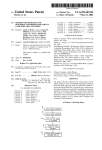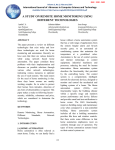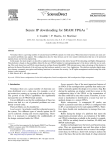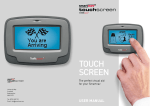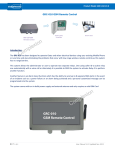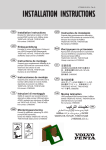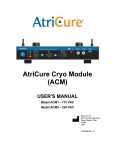Download Bluetooth based home automation system
Transcript
Microprocessors and Microsystems 26 (2002) 281–289 www.elsevier.com/locate/micpro Bluetooth based home automation system N. Sriskanthan*, F. Tan, A. Karande School of Computer Engineering, Nanyang Technological University, Nanyang Avenue, Singapore, Singapore 639798 Received 17 September 2001; revised 8 May 2002; accepted 10 May 2002 Abstract The past decade has seen significant advancement in the field of consumer electronics. Various ‘intelligent’ appliances such as cellular phones, air-conditioners, home security devices, home theatres, etc. are set to realize the concept of a smart home. They have given rise to a Personal Area Network in home environment, where all these appliances can be interconnected and monitored using a single controller. Busy families and individuals with physical limitation represent an attractive market for home automation and networking. A wireless home network that does not incur additional costs of wiring would be desirable. Bluetooth technology, which has emerged in late 1990s, is an ideal solution for this purpose. This paper describes an application of Bluetooth technology in home automation and networking environment. It proposes a network, which contains a remote, mobile host controller and several client modules (home appliances). The client modules communicate with the host controller through Bluetooth devices. q 2002 Elsevier Science B.V. All rights reserved. Keywords: Bluetooth technology; Microcontroller; Home automation; Wireless network 1. Introduction The Bluetooth wireless technology is set to revolutionize the way people perceive digital devices in our homes and office environment. Now they are no longer just the individual devices; instead, with the embedded Bluetooth technology, they form a network in which appliances can communicate with each other. This wireless technology is especially useful in home environment, where there exists hardly any infrastructure to interconnect intelligent appliances. It could be suitably used for home automation in a cost-effective manner. Operating over unlicensed, universally available frequency of 2.4 GHz, it can link digital devices within a range of 10 m (expandable to 100 m, by increasing the transmitted power) at the speed of 1 Mbps. Building upon this theme; we propose a home automation system based on Bluetooth technology [1,2]. There are certain issues involved in the design of a home automation system. The system should be scalable, so that new device can easily be integrated into it. It should provide a user-friendly interface on the host side, so that the devices can be setup, monitored and controlled. The interface should also provide some diagnostic services so those problems * Corresponding author. E-mail addresses: [email protected] (N. Sriskanthan), [email protected]. sg (F. Tan), [email protected] (A. Karande). with the system, if any, can be tracked down. The overall system should be fast enough to realize the true power of wireless technology. It should also be cost effective in order to justify its application in home automation. The system developed during the course of this research consists of a Host Controller (HC) implemented on a Personal Computer (PC), and a microcontroller based temperature-sensor/fan-controller, that is able to communicate with the host through the Bluetooth link. The system is based on Home Automation Protocol (HAP), developed by the authors in order to facilitate the master– slave communication in a home automation network [3]. This protocol ensures a prioritized, interlocked exchange of data. It also supports dynamic addition and removal of devices on the network. A user interface on the PC offers device registration, control as well as diagnostic utilities. Bluetooth development kit from Ericsson was used for the development [4]. A microcontroller was used as a device controller for client modules [5,6]. The paper has been structured as follows. Section 2 of this paper explains the HAP. Section 3 describes the salient features of the user interface and PC to Bluetooth interface for the host system. In Section 4, we present the temperature sensor– fan controller circuitry and its interface to the microcontroller through I2C lines. Section 5 discusses the microcontroller to Bluetooth interface and the development of a firmware for the microcontroller. Finally some 0141-933/02/$ - see front matter q 2002 Elsevier Science B.V. All rights reserved. PII: S 0 1 4 1 - 9 3 3 1 ( 0 2 ) 0 0 0 3 9 - X 282 N. Sriskanthan et al. / Microprocessors and Microsystems 26 (2002) 281–289 Fig. 1. Bluetooth based home automation system. (a) Host and client modules in a Bluetooth piconet. (b) An individual client module. recommendations regarding further research in this area are discussed. 2. Home Automation Protocol The Home Automation Protocol (HAP) facilitates the communication among the host and client modules in a home automation system. The communication covers the device initialization process and the data transaction process. The protocol is constructed above Bluetooth software stack [7]. It follows the layer model proposed by Bluetooth Special Interest group (SIG). Considering the requirements of home automation environment, the HAP has been based on the core of the Bluetooth protocol architecture that comprises of three stacks: † Logical Link Control and Adaptation Protocol (L2CAP) † Service Discovery Protocol (SDP) † RFCOMM (serial cable emulation protocol) protocol. HAP device initialization process uses the enhanced SDP functionality to query device information and services. L2CAP provides data services to the HAP with protocol multiplexing capability, segmentation and reassembly oper- ations. RFCOMM facilitates wireless communication and provides transport capabilities for home automation services. A typical Bluetooth based home automation system includes a host and several client modules. Considering the entrance price of the Bluetooth, it will be more cost effective to have multiple Device Controllers (DC) connected to a Bluetooth device. Each DC, in turn, monitors multiple Attached Devices (AD) as shown in Fig. 1. 2.1. Home automation descriptor table The host needs to store information regarding all the active devices in the network. Similarly a DC needs to store information pertaining to the devices directly attached to it. The information is stored in the form of descriptors. The formats of descriptors on the DC and the host are shown in Tables 1 and 2, respectively. Descriptor table terms explanation: AD the ID of the attached device TOD the type of Attached Device (I2C address) I_SIZE the instruction size in bytes for given device D_SIZE the data size in bytes for given device D_NAME the device name, a NULL terminated string (32 bytes) RW the read and write access: Read Only ($00), Write Only ($01), Read & Write ($02) N. Sriskanthan et al. / Microprocessors and Microsystems 26 (2002) 281–289 PRIORITY the priority between the various ADs STATUS there are three states for devices: Pending ($00), ACK ($01), NACK ($02) Table 1 DC-side descriptor table AD Status 7-Bits 2-Bits 283 added or removed. If HC does not receive an acknowledgment from the DC, the host assumes that the DC is not working properly or has been removed. The HC will stop transferring any information to the AD of that DC. 2. When a DC finds a new AD or a removed AD while performing a DCP, it sends DDP or DRP to the HC. Depending on whether the HC acknowledges it or not, the DC updates the local descriptor table. 2.2.3. Data transaction process Table 2 Host-side descriptor table TOD I_SIZE þ D_SIZE D_NAME RW Priority 7-Bits 2-Bits þ 3-bits 32-Bytes 2-Bits 7-Bits 2.2. Protocol description Fig. 2 shows the process diagram for HAP. The four indexed activities in the diagram are as follows: (1) DC searches for all existing ADs and places them in the DC descriptor table. (2) HC searches for device information in DC database and constructs the descriptor table. (3) HC periodically checks the status of each DC and requests it to check its devices. (4) DC searches for all the devices and sends back the feedback information. If new device is found, DC sends the Device Detection Packet (DDP). If a device is not found (removed), the DC sends the Device Removal Packet (DRP). The sequence of operations can be categorized into three different processes as follows. 2.2.1. Device initialization process 1. On reset, the HC sends Device Checking Packet (DCP) to each DC. A DC performs a scan on its ADs and sends a DDP to the host for each device found. 2. If the AD information is found on the HC, it will automatically pop up the window for device control. If user acknowledges the device found, an ACKP would be sent back to the DC, otherwise NACKP would be sent. 3. If the new AD is not stored in the HC, HC will pop up window to request user to configure the new AD. If user acknowledges and configures the device, the ACKP would be sent back to the DC, otherwise NACKP would be sent. 1. CMDP (Command packet) will be sent from the HC to a DC in order to control the AD or to retrieve status information of the AD. 2. If the packet received by the DC is to control an AD and no data is required in return, an ACKP will be sent back to the HC, after executing the necessary commands. 3. If the command packet requests for data, a DATAP (Data packet) will be sent back to HC. All packet formats are described in Section 2.3. 2.3. Packet formats The following are abbreviations for packet format. PIT packet type identifier to indicate the packet type DC þ AD define the Device Controller and the Attached Device I_SIZE define the instruction size in bytes for given device D_SIZE define the data size in bytes for given device INSTRUCTION define the instruction contents DATA define the data contents. (1) DDP (Device Detection Packet). This packet is to inform the host a new device is attached to the network and need to be configured (Table 3). (2) DRP (Device Removal Packet). This packet is to inform the host that a device has been removed (Table 4). (3) DCP (Device Checking Packet). This packet is to inform a DC to send back an acknowledgement to the HC and check the status of an AD (Table 5). (4) ACK (Acknowledgement Packet) (Table 6). (5) NACK (Non-Acknowledgement Packet) (Table 7). (6) CMDP (Command packet). This packet is sent by the HC to control the AD or request for AD status information (Table 8). (7) DATAP (Data packet). This packet is to transfer device information back to the host (Table 9). Table 3 Device detection packet 2.2.2. Periodic checking process 1. Host periodically sends the DCP to a DC to check if it is working properly and whether any new AD has been PIT DC þ AD $00 3-Bits þ 7-bits 284 N. Sriskanthan et al. / Microprocessors and Microsystems 26 (2002) 281–289 Fig. 2. Transformation process diagram of home automation system. Table 4 Device removal packet Table 7 Non-acknowledge packet PIT DC þ AD PIT DC $01 3-Bits þ 7-bits $B0 3-Bits þ 7-bits Table 5 Device checking packet Table 8 Command packet PIT DC PIT DC þ AD I_SIZE þ D_SIZE $10 3-Bits $A0 3-Bits þ 7-bits 2-Bits þ 3-bits Table 6 Acknowledgement packet Instruction Data Table 9 Data packet PIT DC þ AD PIT DC þ AD D_SIZE $B1 3-Bits þ 7-bits $A1 3-Bits þ 7-bits 3-Bits Data N. Sriskanthan et al. / Microprocessors and Microsystems 26 (2002) 281–289 285 to enter a set of new information and register as a new device. 3. Bluetooth home automation PC software The Bluetooth home automation PC software module is the main Host Control Application (HCA) for other DCs. The HCA provides three main services to the users, namely: 1. Device Registration 2. Diagnostics utility 3. Device Status and Control. 3.1. Device registration The home automation system supports a Plug and Play (PNP) methodology, which means a new device, can be added readily to the system [8]. In order to handle dynamic addition of new devices and to reduce the complexity of the client software, a device database is stored on the HCA [9]. This device database holds information about each type of device that is supported, similar to printer drivers in PC. If a new device needs to be added, it could be registered using the device registration utility. The database can be considered as a driver for each of the client modules. The information required to identify each device is the following (Table 10). The entire database is stored in the initialization file located in the system’s Windows directory. The initialization file also contains other user settings required to configure the serial port for communicating with the Bluetooth Toolkit. The menu includes an Open File option, which allows an initialization file to be loaded from disk. Similarly, a Save File option would allow this file to be saved in disk for backup purposes. Upon startup of the program, a graphical user interface (GUI) will be presented. The information of each registered device would be added to a device list. When the user selects the Registration Tab, this device list and information on each selected registered device will be presented to the user for selection. After each device’s information is displayed, the user can choose to edit the device information of the selected device or to add a new device. If either of these options is chosen, a new interface would be displayed in the same type which allows the user to change the existing device information or 3.2. Diagnostics utility The diagnostics utility provides the HC a means to test essential Bluetooth communications with the DC connected to it at the application level. It allows the user to connect the HCA to the DC and send data to it. This utility is useful during the development phase and also essential for troubleshooting purposes. The access to the utility functions are provided through a user friendly GUI. Upon start up, the correct serial port as indicated in the user setting menu would be connected at the specified baud rate. The user settings menu will be saved in the initialization file upon termination of the application. After a connection to the specified serial port is made, the user can perform diagnostic Bluetooth functions. The Bluetooth functions provided on the HCA are the Reset, Connect ACL (Asynchronous Connection-Less link) or SCO (Synchronous Connection Oriented link), Disconnect, Inquiry, Board Address and Send Data. The sequence of operations for a normal data connection from the HCA is highlighted in the sequence below: 1. Perform a Reset operation to initialize the Bluetooth. 2. Perform an Inquiry operation to search for all the Bluetooth devices present on the piconet. 3. After obtaining a client Bluetooth address, a Connect ACL operation to this address is required to setup the connection for data transfer. 4. After the ACL connection is successful, data could be entered in the data entry textbox and sent to the client through the Send operation. 5. After all data are transferred, a Disconnect operation is performed to terminate the Bluetooth connection. 3.3. Device Status and Control The Device Status and Control application is the main application to control and monitor ADs. In contrast to the Diagnostics utility, which can also be used to obtain status information about an AD and to control the device, the Table 10 Device information stored in device database Field name Description Device Type ID Device Name Read/Write Type Priority Instruction Size Data Size Uniquely define each type of device. Current system supports 128 devices. (7-bit AD) Name of the device Specifies whether the device is Read Only, Write Only or both Specifies the priority level of the device Specifies the size of each instruction Specifies the size of the data 286 N. Sriskanthan et al. / Microprocessors and Microsystems 26 (2002) 281–289 Device Status And Control application does the same functions at a hidden layer. Using the GUI a list of ADs would be displayed for Registration. When an AD is selected, the related device information will be obtained from the connected device at a hidden layer, which consists of ACL connections, data transfers and disconnect operations. The data transfers and connection operations are compliant with the protocol to synchronize the transfer between the HC and a DC. In addition, the protocol provides different packets to be sent for different purposes and all these operations are performed at a hidden layer. At this level the user is not concerned with the packet formats and the protocol between HC and DC. Besides obtaining the AD status, the user can also choose to control the AD. When the user selects the AD and the control option is selected, control values can be sent to the AD and depending on the type of device, the DC will be able to use these values to control the AD. 4. Hardware design and development A temperature-sensor/fan-controller circuitry has been developed to demonstrate the feasibility and effectiveness of the application. The hardware interface component of the Bluetooth based home automation system consists of a Microcontroller –Transducer interface through I2C bus and an RS232 link between the microcontroller and the Bluetooth. Thus the microcontroller acts as a DC and the temperature-sensor/fan-controller IC act as ADs. 4.1. Microcontroller –Transducer interface In order to minimize the cost of the overall system, it is desirable to have multiple appliances connected to a single Bluetooth, with one or more microcontrollers monitoring them. I2C bus is a suitable choice for such a network of appliances. I2C is the acronym for Inter-IC Connect bus, which is a synchronous serial bus, developed primarily by Philips Semiconductors [10,11]. Currently there are over 1000 devices that are registered as licensed components with assigned addresses and various enhanced versions of the I2C bus protocols have been introduced. 4.2. I2C protocol The I2C bus is implemented using 2-wires to communicate data serially among devices. One line is called SCL (Synchronous Clock) while the other one is known as SDA (Synchronous data). Devices on the bus can either be in a multi-master, single-master environment or in slave mode. The master device generates the clock signals and initiates the data transfer on the bus. Fig. 3 shows a typical operating environment of the I2C bus where microcontroller A and B can operate as master or slave while other peripherals operate in slave mode only [12]. 4.3. Room temperature control system The system consists of a temperature sensing circuit, which is used to track the room temperature and a fan control circuit that is used to regulate the room temperature as shown in Fig. 4. The controller IC chosen incorporates a precise digital thermometer to measure the temperature from a remote sensor along with an on board fan controller [13,14]. The controller IC, from a programmer’s perspective, looks like a set of byte-wide registers that contain temperature data, alarm threshold values or control bits. The WHI register determines the highest temperature limit (THigh) that the temperature sensor can sense, while the WLOW register give the lower temperature limit (TLow). These values then can be adjusted easily to measure the room temperature thereby increasing the resolution of the measured temperature. The WCRIT register specifies the critical over-temperature (TCrit) value for the system. The RTEMP contains the latest temperature value provided by the ADC after sensing the remote diode. The ALERT interrupt is asserted when the value in the RTEMP register exceeds the user-defined temperature range specified by the values of THigh and TLow registers. In response to this the microcontroller can be programmed to instruct the Controller IC to do specific tasks viz. start the fan. The OVERT interrupt is activated when the values in the RTEMP register equals to or exceeds the TCrit value. When this OVERT interrupt is asserted, the microcontroller can be programmed to raise an alarm. The chip also has a Fig. 3. Example of multi-master operating environment for the I2C bus [2]. N. Sriskanthan et al. / Microprocessors and Microsystems 26 (2002) 281–289 287 Fig. 4. Room temperature control circuit [14]. continuity fault detector which detects whether the remote diode has an open-circuit condition or short-circuit condition to GND. This diode fault will also assert the ALERT interrupt. This system simulates a room environment where the user sets the range of temperature values for the room. These values are then communicated to the DC after the Bluetooth connection takes place. The DC then generates the necessary commands via the I2C serial bus. The DC continuously tracks the room temperature. If the room temperature exceeds the THigh value, the DC will instructs the Controller IC to start the fan in order to reduce the temperature of the room. If TLow is less than or equal to the preset value, the temperature can be raised using a heater, which is currently out of the scope for this report. If the room temperature exceeds the critical temperature, for example when there is a fire in the room and the room temperature raises, the DC raises an alarm, which is a safety measure, provided by the system. 5. Software development The firmware for the microcontroller was developed using assembly and C language. The software module controlling the Bluetooth includes: a set of instructions necessary to initialize the Bluetooth device after power-onreset, configure it to identify itself on Bluetooth piconet, accept the connection request from the host, establish the connection, and handle the subsequent exchange of data. The exact sequence of events after power-on-reset is given in Fig. 5 [15]. Each of these processes involves sending/accepting a series of bytes to/from the Bluetooth module through RS232 interface. These bytes are defined according to Bluetooth L2CAP (Logical Link Control and Adaptation Protocol) packet format; for example, L2CAP instructions start with byte 0 £ 01, L2CAP data packets begin with byte 0 £ 02, etc. [4]. The significance of the processes shown in Fig. 5 is explained below: † Reset. It is an L2CAP instruction. This command resets the Bluetooth module and is usually used after power-onreset. † Scan. This L2CAP instruction sets the module in standby scan mode. In this mode, a Bluetooth module waiting to join the piconet can identify itself. † Auto Accept. This instruction sets the module in auto accept mode, in which it can readily accept the connection request from the master as soon as it arrives. After receiving each of these commands, the Bluetooth module sends back an acknowledgment. Finally, after the ACL (or SCO) connection is established, it sends a data packet to the microcontroller. The packet contains the information like the connection handle, board address of the Master, etc. Once the connection is established, it remains valid until either the HC or the DC drops out. The DC then waits for a command from the HC side. When DC receives a command from its Bluetooth module, it extracts the actual HAP instruction from the L2CAP envelope, identifies it, executes it and sends either acknowledge or a data packet to Bluetooth module for transmission. Software based I2C bus controller module was developed for microcontroller. It manipulates two I/O pins of the microcontroller so that I2C protocol based communications are carried out via the two of its pins. The home automation, HCA software was run on the PC acting as a host. The microcontroller programmed in the 288 N. Sriskanthan et al. / Microprocessors and Microsystems 26 (2002) 281–289 Fig. 5. Transformation diagram to establish ACL connection. manner explained above acted as a DC. The system was tested to ensure its conformance to the Home Automation Protocol. A communication link was established between a PC and the microcontroller through Bluetooth devices. The host successfully controlled the temperature-sensor and fancontroller to a preset value. The steps used to implement and test the HAP are as follows: † The temperature sensor and fan controller is registered on the PC and an AD address is provided † Functionality to interpret and respond to the instruction from the host is added to the microcontroller program. This includes functions to read the temperature from the AD and control the fan speed according to the instructions from the host. † Both the host and the DC are reset. After the ACL connection is established, the HC requests the DC to check for registered devices. † The DC receives acknowledge from the temperature sensor and responds positively to the host. † Now, each time the DC receives a command, it checks whether it is intended for it, and if it is, then it checks which AD is to be handled from specific bit-fields in the command. † The host sends requests for temperature data. The DC interprets the HAP instruction and executes the function to access the sensor and read the temperature. It sends the temperature data to the host. † Similarly, it responds to the periodic checking commands from the host by accessing the AD (sensor) and checking for acknowledge. Thus, the functionality of the protocol is verified for a network, which consists of a single DC. The HAP consists of specific bit-fields to identify different DCs and the corresponding ADs, therefore the system can be easily extended to accommodate multiple DCs. Such system can be tested, if multiple Bluetooth devices are available. The HAP is independent of the lower level Bluetooth protocols, is designed to work in a piconet of Bluetooth devices. 6. Conclusions and recommendations The objective of this proposal was to develop a home automation system based on Bluetooth wireless technology. The result is the HAP, which allows the user to monitor and control different appliances connected over a Bluetooth network in home environment. The system has been demonstrated to be functioning by developing a room temperature control system. The nature of this project is such that it provides a great N. Sriskanthan et al. / Microprocessors and Microsystems 26 (2002) 281–289 scope for further developments. In this system, the error detection and correction facility is only handled at the Bluetooth level. Similar facility can be developed at the application level. Also, some security measures to avoid interference of neighboring home automation systems can also be incorporated into the application. The functionality of the HAP can be tested for a larger network, using multiple Bluetooth devices. For this project, we have used I2C interface between the DC and the ADs. One can explore the possibility of a parallel interface for faster appliances, or power line interface, etc. In our application one Bluetooth module is associated with only one DC. However, one can assess the viability of a multi-drop RS232 interface between a Bluetooth module and DCs. Of course, in ideal situation, each appliance will have its own Bluetooth module. With the explosion Internet and related technologies, the home system looks set to enter this arena. The home-office concept that enables consumers to control their home appliances via the Internet is also possible. With our home system, which consists of the HC that usually takes a form of PC, Internet connectivity can easily be established and control be made available. Efforts in such direction will help realize a truly wireless, fully automated home automation system. 289 [12] I2C Serial Bus Analyzer, N. Sriskanthan, Tan Sue Lim, IWNA’01, Singapore, 2001, p. 106–114. [13] Maxim Integrated Products, Max233 12V Line Driver Chip Datasheet, 2000. [14] Maxim Integrated Products, MAX1669 Fan controller and Remote Temperature Sensor Datasheet, 2000. [15] W. Stalling, Data and Computer Communications, Prentice Hall, Englewood Cliffs, NJ, 1997. Nadarajah Sriskanthan, Associate Professor, School of Computer Engineering, Nanyang Technological University, Singapore. He received the BSc degree in Electrical Engineering from the University of London and the MSc degree in Electronic Equipment Design from Cranfield Institute of Technology, UK. He worked in various electronic industries in UK from 1972–1978. From 1982–1984, he was at Cranfield Institute of Technology as Research Officer. Since 1985, he has been teaching Microprocessors and Computer Interfacing Techniques, Digital TV and Multimedia Systems Design at the Nanyang Technological University. His research interests are in developing computer interface hardware and software, particularly for the application of Computer Graphics, Digital Video Broadcasting, Multimedia Technology, Internet Based Training Systems, Bluetooth and Multiprocessors Acknowledgments Authors like to acknowledge the contribution, to the project by the following under graduate students: Miss He Yuxiong, Mr Ranadive Rohan Suresh, Mr Teo Chee Beng, from the School of Computer Engineering, Nanyang Technological University. References [1] The official Bluetooth website from Bluetooth SIG www.Bluetooth. com, Date viewed: March 21, 2001, Bluetooth Specification Version 1.1. [2] Bluetooth Committee, Specifications of the Bluetooth System (Core), December 1999, V1.0B. [3] Home System Specification, EHS, 1997. [4] Ericsson Mobile Communications AB, User Manual—Bluetooth PC Reference Stack, 1543 VNX 2/901 184 Uen Version R1a, April 2000. [5] I.S. McKenzie, The 8051 Microcontroller, Prentice Hall, Upper Saddler River, NJ, 1999. [6] Phillips Semiconductors, 87C51 8-bit Microcontroller Data Sheet, 1999. [7] Bluetooth Committee, Profiles of the Bluetooth System (Profiles), December 1999, V1.0B. [8] J. Kelsey, Programming Plug and Play, Sam’s Publication, 1995. [9] USB Design By Example, A Practical Guide of Building I/O Devices, John Hyde, Wiley, New York, 1999. [10] Philips Semiconductors, The I2C Bus Specification, Version 2.1, January 2000. [11] Philips Semiconductors, The I2C Bus and How to Use It (Including Specification, Version 1.0), Technical Manual, 1997. Forest Tan Su Lim is a Senior Tutor with the School of Computer Engineering at the Nanyang Technological University (NTU), Singapore. He received the B.A.Sc. degree in Computer Engineering from NTU and his Diploma in Electronic and Computer Engineering from Ngee Ann Polytechnic, Singapore. He has been lecturing in the area of digital circuit and system, and computer peripherals. He worked as a software engineer at Philips Singapore to implement a tuner test system at the Tuner R&D laboratory during industrial attachment and a software engineering in the Defence Science and Technological Agent (DSTA) System and Computer Organisation (SCO) arm. His research interest includes system integration design and application, digital television decoding and home automation implementation. Karande Advait is a third year honours year student in Computer Engineering course in the School of Computer Engineering, Nanyang Technological University. His interests are Microprocessors, Bluetooth and Electronic Design.









